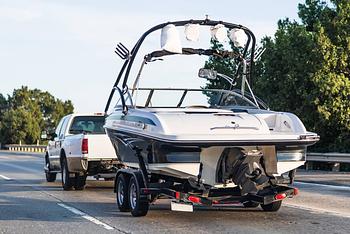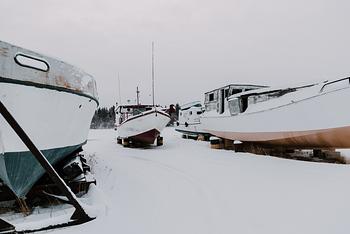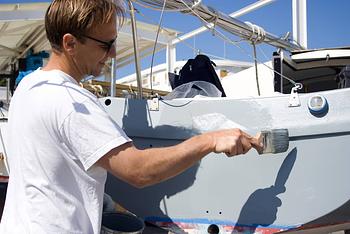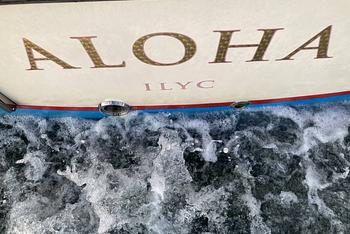For many boaters in the northern hemisphere there comes a time in the fall when we have to admit that it’s time to winterize our boat. We’ve dragged out as many glorious boating days as we possibly can and it’s now time to reluctantly tuck her up until the spring. Winterizing a boat involves protecting it from the effects of freeze damage, as well as protecting it from weathering and the growth of mold and mildew. While the extent to which you need to winterize your boat depends on the severity of the conditions where you live, there are some basics to getting a boat ready for winter that everyone will need to consider. In a previous guide we looked at how to winterize your boat in general, from cleaning it thoroughly, to draining all the systems, to covering it and preparing the engine for winter.
Here we take a closer look at the steps you need to take to winterize a boat engine:
- Do you need to winterize a boat motor?
- Step-by-step guide to winterizing an outboard motor
- Step-by-step guide to winterizing an inboard motor
- FAQs on How to Winterize a Boat Motor

Do You Need to Winterize a Boat Motor?
If you live in an area where the temperature may drop below freezing, the simple answer is yes. To protect your boat’s motor during the colder winter months there are some steps you’ll need to take to ensure that the damaging effects of water won’t ruin what is arguably the most expensive part of your boat. When a motor isn’t winterized, water may be left in certain parts which, when temperatures drop below 32 degrees fahrenheit, can freeze and expand, creating pressure on those parts. As this freezing and thawing action may occur multiple times over the winter, this can make the problem even worse.
However it isn’t just freezing water that causes damage. Water in general, as well as high humidity levels in winter months, can cause corrosion to parts of the motor. While it might seem at first like a lot of work, winterizing your boat isn’t complicated, and it’ll keep your motor healthier for longer.
There are three main steps for winterizing all boat motors:
-
Change the Oil and Oil Filter: Impurities and moisture in the motor’s oil can cause damage over the winter, so an important step is changing the oil and filter. Once you’ve changed them, run the motor for a few minutes to circulate the new oil throughout all the parts.
-
Change the Fuel Filter and Stabilize the Fuel: Over winter the ethanol in gasoline can absorb water and cause it to separate from the gas, causing corrosion in the fuel tank. One way to overcome this is to empty all the gas from the fuel tank as part of the winterizing process, but that isn’t practical in most cases and also introduces the possibility of condensation forming in the empty tank. The best alternative is to fill the fuel tank almost to the top and add a stabilizer which prevents phase separation.
-
Drain the Water from the Engine and/or Use Antifreeze: This is the most important step in winterizing a boat motor, and varies depending on whether you have an inboard or outboard motor.
Step-by-Step Guide to Winterizing an Outboard Motor
-
Flush the motor with fresh water: The engine needs to be flushed thoroughly according to manufacturer’s instructions – either by running it in clean, fresh water or by adding a hose that can flush without the engine on.
-
Drain and replace the engine oil and filter: Drain out and change the powerhead oil (in four-strokes; if you have a two-stroke you can skip this step since its lubrication comes from oil in the fuel and there is no powerhead oil). Run the engine first to ensure any contaminants are picked up in the oil.
-
Change the oil in the gear case: Change the lower unit oil in the gear case and replace the seals on the drain plugs.
-
Fog the engine: Fog the engine to put a protective coating of oil on its internal parts. In some cases fogging is done by running the engine with a special fuel additive and in others fogging oil is sprayed directly into the engine, and different engines have different requirements, so follow the manufacturer’s recommended procedure.
-
Treat the fuel: Add a stabilizer.
-
Cover the engine: If possible cover the engine for added protection against the elements.
-
Store the engine: If your engine is a small outboard then consider taking it home with you to store in a dry place. Otherwise store it in the running position (ie tilted down) to prevent water ingress.

Step-by-Step Guide to Winterizing an Inboard Motor
While the main idea is the same when it comes to winterizing an inboard motor versus an outboard motor, there are some differences in the approach. While outboard motors are attached to the stern of the boat, and small ones are even easily removed, inboard motors are found in the hull of the boat, either in the bilge or, for much larger boats, their own separate engine room.
Here we are focusing on do-it-yourself winterizing of inboard engines as many larger boats will leave it to professionals.
-
Flush the motor with fresh water: he engine needs to be flushed thoroughly according to manufacturer’s instructions, usually via a regular garden hose.
-
Drain and replace the engine oil and filter: Flush out and change the oil according to manufacturer’s instructions. Run the engine first to ensure any contaminants are picked up in the oil.
-
Remove the spark plugs: This is a good time to change them if required as part of your ongoing maintenance schedule, and fog the inside the cylinders.
-
Add antifreeze: At this point you’ll want to fill the cooling system with a good quality antifreeze. Make sure you have enough antifreeze before starting (at least two gallons but even as much as five). With some systems you can put the intake hose in a bucket of antifreeze, and run the engine at idle until antifreeze discharges from the exhaust outlet. But there are several different types of cooling systems so refer to the manufacturer’s recommended procedures.
-
Add fogging lubricants: Fog the engine to put a protective coating of oil on its internal parts. In some cases fogging is done by running the engine with a special fuel additive and in others fogging oil is sprayed directly into the engine, so follow the manufacturer’s recommended procedure.
-
Cover the boat: In our guide how to winterize your boat we looked at the pros of covering your boat throughout the winter months, and the different options there are for doing so. These include plastic tarps, canvas tarps, fitted covers and shrink wrapping.

FAQs on How to Winterize a Boat Motor
Are coolant and antifreeze the same thing?
Despite often being confused as the same, they are in fact two different products and have different purposes. The engine coolant’s main function is to regulate engine temperature, while antifreeze is used to prevent freeze damage. Ethylene gylcol mixed with water often serves the purposes of both a coolant and an antifreeze in an engine. But it’s poisonous, so only propylene glycol can be used as an antifreeze in other systems of the boat (such as the freshwater system).
Do I need to add antifreeze to an outboard engine?
As long as the engine is stored properly (in the full down position) the answer is no. Outboards are designed to drain completely when tilted down, so if you run antifreeze through one, it just drains right back out.
How Can I Winterize My Boat in an Eco-Friendly Way?
Winterizing products are notoriously unfriendly to the environment, but there are some ways you can limit the negative effects. The best antifreeze to winterize a boat engine environmentally is to use propylene glycol antifreeze, which is less harmful to marine life. When flushing the antifreeze try and catch it in a bucket to dispose of safely (talk to your local marina about disposal of hazardous waste) rather than letting it discharge overboard. When using oils you can place an absorbent pad under your work area to catch spills and drips, as well as working with smaller containers of hazardous fluids – accidents happen and smaller containers mean smaller spills. Also be sure to recycle the shrink wrap if you have your boat wrapped for winter storage. Many marinas have shrink wrap recycling programs but remember that you must remove the straps, zippers, and vents before the wrap can be recycled.
Related articles
Related Articles and Guides
29th Mar 2024
How to Transport Your Boat Four Different Ways
18th Oct 2023
How to Winterize a Boat: Steps, Checklist and Costs
20th Sep 2023
Painting a Fiberglass Boat: A Detailed Guide
19th Sep 2023






